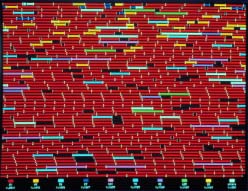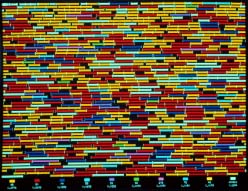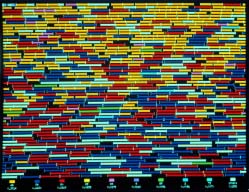 Hosts, red, are very common. Parasites, yellow, have appeared
but are still rare.
Hosts, red, are very common. Parasites, yellow, have appeared
but are still rare.
In an attempt to create conditions under which evolution might express itself in the digital medium with a creativity analogous to what we have seen in the organic Cambrian explosion, I have proposed the creation of a ``biodiversity reserve for digital organisms'', a kind of wildlife reserve in cyberspace. The network installation of Tierra [6,7,8] creates a new web within the internet that is inoculated with digital organisms which are allowed to evolve freely through natural selection.
This web will have a complex topology of interconnections, reflecting the topology of the internet within which it is embedded. In addition, there will be complex patterns of ``energy availability'' (availability of CPU cycles). Consider that each node on the net tends to experience a daily cycle of activity, reflecting the habits of the user who works at that node. The availability of CPU time to the Tierra process will mirror the activity of the user, as Tierra will get only the cycles not required by the user for other processes. Statistically, there will tend to be more ``energy'' available for the digital organisms at night, when the users are sleeping.
There will be selective pressures for digital organisms to maintain themselves on nodes with a high availability of energy, by sensing and responding to temporal and spatial patterns of resources (such as CPU ``energy''). This might involve daily migrations around the planet, keeping on the dark side. In short, the digital organisms must be able to intelligently navigate the net in response to dynamically changing circumstances.
In addition to responding to conditions on the net itself, digital organisms evolving in this environment will have to deal with the presence of other organisms. If one node stood out above all the rest, as the most energy rich, it would not be appropriate for all organisms to attempt to migrate there. They wouldn't all fit, and if they could they would have to divide the CPU resource too thinly. Thus there will be selection for social behavior, flocking or anti-flocking behavior. The organisms must find a way of distributing themselves on the net in a way that makes good use of resources.
The complex topology of the network, and the heterogeneous and changing patterns of energy availability should favor the selection of behavior more complex than simple reproduction. It is hoped that this will launch evolution in the direction of more complexity. Once this trajectory has begun, the interactions among the increasingly sophisticated organisms themselves should lead to further complexity increases.
In the original single node Tierra, most of the evolution observed involved the adaptation of organisms to other organisms (parasitism, immunity, social behavior, etc.) [6] (Figure 4). It is this kind of dynamics that can lead to an auto-catalytic increase in complexity and diversity in an evolving ecological system. The complexity of the physical system in which evolution is embedded does not have to lead the complexity of the living system.
Figure 4: Evolutionary race between hosts and parasites in a soup of the Tierra program.
 Hosts, red, are very common. Parasites, yellow, have appeared
but are still rare.
Hosts, red, are very common. Parasites, yellow, have appeared
but are still rare.
 Hosts, are now rare because parasites have become
very common. Immune hosts, blue, have appeared but are rare.
Hosts, are now rare because parasites have become
very common. Immune hosts, blue, have appeared but are rare.
 Immune hosts are increasing in frequency, separating the
parasites into the top of memory.
Immune hosts are increasing in frequency, separating the
parasites into the top of memory.
 Immune hosts now dominate memory, while parasites and susceptible
hosts decline in frequency. The parasites will soon be driven to
extinction. Each image represents a soup of 60,000 bytes, displayed
as 60 bars of 1000 bytes each. Each individual creature is
represented by a colored bar, colors correspond
to genome size (e.g., red = 80, yellow = 45, blue = 79).
Immune hosts now dominate memory, while parasites and susceptible
hosts decline in frequency. The parasites will soon be driven to
extinction. Each image represents a soup of 60,000 bytes, displayed
as 60 bars of 1000 bytes each. Each individual creature is
represented by a colored bar, colors correspond
to genome size (e.g., red = 80, yellow = 45, blue = 79).